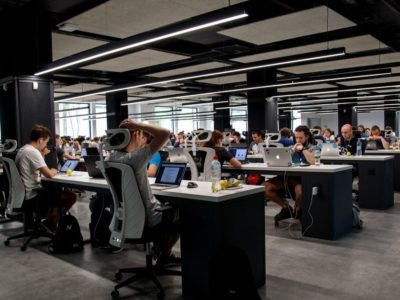“The future is already here. It’s just not very evenly distributed.”
It’s not every day that science fiction author William Gibson is quoted in discussions about how we use offices.
Yet, his thoughts about transformation and acceleration have never been more relevant, according to the speakers in a recent Nimbus Ninety webinar on the topic of workforce transformation.
It has become something of a trope to read about a ‘new normal’ where remote work is the expectation as opposed to an anomaly. Yet we’ve had the capabilities to empower staff remotely for many years. Only during COVID-19 was its adoption evenly distributed as the pandemic acted to accelerate existing trends.
The need for a fundamental reappraisal of work
That acceleration of transformation over the past year has prompted leaders to take a step back to reappraise what work is to their business – and therefore how it can be best completed.
A significant amount of work that happens every day is already digital and has been done that way for many years. But other tasks had previously relied on face-to-face collaboration. We’ve seen more and more businesses look to objectively define what work, and even workplaces, mean to their staff and their organisation so they can ensure they have the right offices and technology to be productive.
In a future that is increasingly uncertain, it’s clear that whatever the response organisations choose, it has to be robust across any and every scenario. Increasingly that means designing our organisations and our technology to be flexible and agile.
Transforming technology
Flexibility and agility require a transformation of both behaviour and technology.
In fact, during the early stages of the pandemic, enforced remote working saw organisations change tack quickly and implement new systems to help work happen. In many ways, it became the world’s biggest remote working experiment, as legions of workers began using video meetings, cloud applications, and collaboration technologies for the first time.
These changes were required to keep disparate, siloed staff engaged. We saw a huge uptick in the use of applications like Microsoft 365, SharePoint, and Teams. People began to see the value of digitally working together at the same time, on the same document.
Those benefits weren’t limited to the organisation itself either. We saw several examples where businesses invited partners and customers into their workflows to collaborate on a shared goal. Getting the technology right to optimise those initial investments has created a new world of opportunities.
Yet, that freedom has to be balanced with security and privacy requirements, especially as new solutions and ways of working are bedded in.
“While a lot of solutions were deployed in the pandemic rush, it’s now time to optimise and secure that infrastructure,” said one of our webinar attendees. “It’s essential we get the governance and policies in place to enable people to keep control of their data.”
That approach rang true across industries. While there was previously a ‘less is more’ approach for many technology teams, the pandemic has shown we have to be more comfortable sharing data beyond the boundaries of the organisation and finding the middle ground to balance collaboration and security.
It’s accepted that working from home at scale is not only possible, but preferable in some situations. As we move to a more hybrid way of working, we need to remove any lingering obstacles to enabling work while still ring-fencing those critical areas that have to be held tightly.
Transforming culture
But it’s not only technology that has had to change. Our personal working styles have been challenged to evolve as well.
As ways of working have changed, so have the demands from teams. Employees now have more insight into the lives of leaders and how their stakeholders juggle life and work. New conversations are emerging as people increasingly want to hear about the life that’s going on in the rooms they can see in their video call windows.
Yet, in addition to that need for intimacy, teams are also crying out for an increased frequency of engagement. They want more conversations with, and more authenticity from, their leaders. The comfort employees used to get from structure and routine has been lost. Instead, teams are being anchored through more regular touchpoints and more genuine conversations.
The ability for leaders to be seen and heard has enormous consequences across the business. First and foremost, leading by example helps make it easier for staff to have difficult conversations if they have already seen their senior stakeholders admit to similar challenges.
A workplace for the future
So, what do those changes mean for how – and where – we work in the months and years to come?
What is clear is that the genie is out of the bottle when it comes to remote work. New hybrid models of working will not only change people’s homes as we create new places to work, but it will also impact offices as space will increasingly be used flexibly to encourage collaboration.
Yet, the strength of a business will always be in its people. As the panellists concluded, a culture founded in purpose, enabled by great ways of working, and supported by technology will be how we define the ideal workplace of the future.
To hear more from Jon and the other panellists on Realising the Modern Workplace, listen to the whole webinar recording here.



